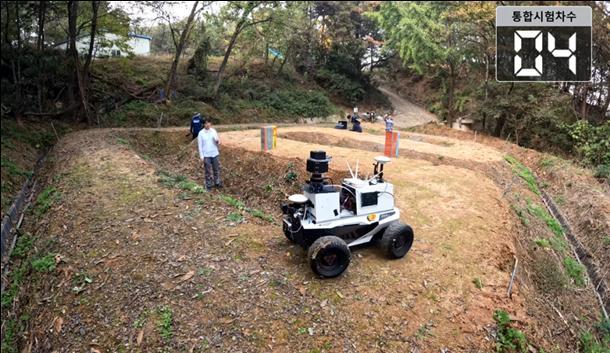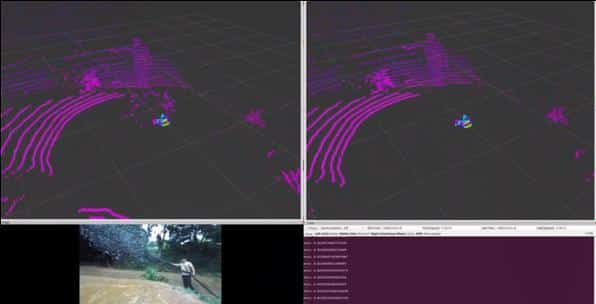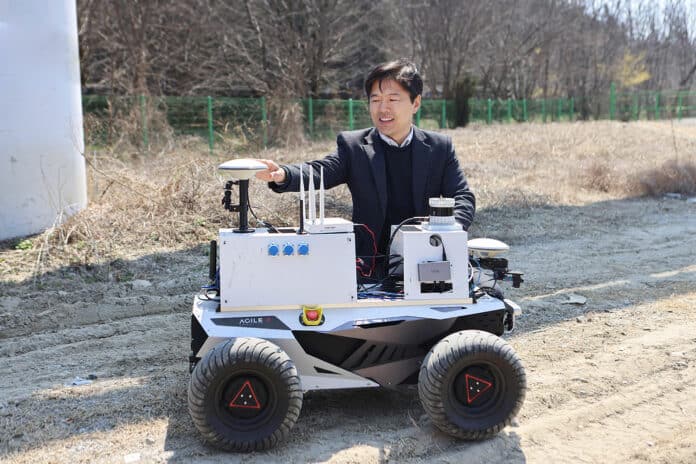Off-road environment recognition technologies have been developed for detecting extraneous substances such as dust, mud, snow, or rain during the autonomous off-road driving of construction machinery, agricultural machines, and unmanned ground vehicles (UGVs). These technologies can remove the sensor signals of these substances in real-time.
It’s expected that these newly developed technologies will be applied in the future to industrial machinery such as excavators, dump trucks, and search vehicles, providing workers with a safer working environment. Furthermore, these technologies have the potential to be applied in military self-driving cars as well.
A research team led by Senior Researcher Han-Min Lee at the Department of Industrial Machinery DX under the Virtual Engineering Platform Research Division of the Korea Institute of Machinery and Materials (KIMM) has developed off-road environment recognition technologies for driving in off-road environments such as mountainous, waterside or snowy regions,

These technologies include sensor protection and cleaning, sensor signal correction, and drivable area recognition, which have been transferred to relevant corporations.
Among the newly developed off-road environment recognition technologies, the “sensor protection and cleaning module” technologies can be used to spray detergents on muddy water or mud that may splash onto the sensor during off-road self-driving and wipe them away in real-time using a wiper, which can help to almost completely remove the contaminants.
Additionally, the “sensor signal correction” technology can help remove small-sized extraneous substances like dust, snow, and rain that can be generated while driving. This can help to maintain off-road self-driving conditions even under unstructured environmental conditions like bad weather.
The KIMM’s drivable area estimation technology can detect various obstacles, including steep slopes, potholes, and bumpy roads, and even identify alternative routes to avoid those obstacles. This feature is really helpful in preventing machinery or vehicles from colliding with other objects. Also, the KIMM has developed a driving control technology that enables real-time control of a vehicle’s driving on a real-time basis by selecting, among the various technologies described above, only the functions that are needed.

Previously, there hasn’t been any suitable sensor protection technology for off-road environments where dirt and mud adhere to vehicles. Additionally, there is no technology that can remove the sensor signals of extraneous substances like dust, snow, or rain in real-time when these substances are included in LiDAR or camera sensor signals.
Another issue is the lack of real-time drivable area estimation technologies that can recognize bumpy obstacles such as trees and rocks and hollow obstacles like cliffs and pits. By the way, LiDAR is a sensor that is used to measure the distance and shape of objects using a laser. The distance can be calculated by discharging a laser and measuring the time it takes for the laser to reflect, and the intensity of the reflected signal can also be obtained.
The newly developed off-road environment recognition technologies have improved processing speed by more than 1.5 times while maintaining high performance indicators such as sensor contamination recovery rate, sensor noise removal accuracy, and off-road drivable driving area estimation accuracy, paving the way for the practical use of these technologies in controlling off-road self-driving.
“These are technologies for resolving the issue of environment recognition, which can be a dangerous obstacle during off-road autonomous driving.” Senior Researcher Han-Min Lee of the KIMM said, “We will make all-out efforts so that the technologies that we have newly developed can be applied not only to the self-driving of industrial machinery such as excavators, dump trucks and tractors but also to the autonomous driving of unmanned military vehicles like tanks and search vehicles.”
